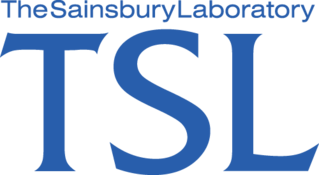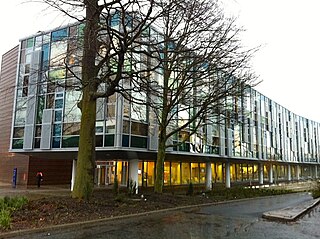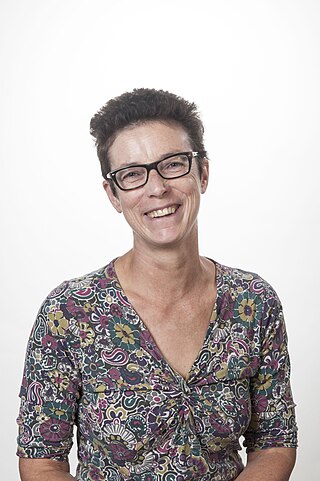
Anglia Ruskin University (ARU) is a public university in East Anglia, United Kingdom. Its origins are in the Cambridge School of Art (CSA), founded by William John Beamont, a Fellow of Trinity College at University of Cambridge, in 1858. It became a university in 1992, and was renamed after John Ruskin, the Oxford University professor and author, in 2005. Ruskin gave the inauguration speech of the Cambridge School of Art in 1858. It is one of the "post-1992 universities". The motto of the university is in Latin Excellentia per societatem, in English Excellence through partnership. Anglia Ruskin University was named University of the Year 2023 by Times Higher Education.

The John Innes Centre (JIC), located in Norwich, Norfolk, England, is an independent centre for research and training in plant and microbial science founded in 1910. It is a registered charity grant-aided by the Biotechnology and Biological Sciences Research Council (BBSRC), the European Research Council (ERC) and the Bill and Melinda Gates Foundation and is a member of the Norwich Research Park. In 2017, the John Innes Centre was awarded a gold Athena SWAN Charter award for equality in the workplace.
Biotechnology and Biological Sciences Research Council (BBSRC), part of UK Research and Innovation, is a non-departmental public body (NDPB), and is the largest UK public funder of non-medical bioscience. It predominantly funds scientific research institutes and university research departments in the UK.

NBBJ is an American global architecture, planning and design firm with offices in Boston, Columbus, Hong Kong, London, Los Angeles, New York, Portland, Pune, San Francisco, Seattle, Shanghai, and Washington, D.C..

The Sainsbury Laboratory (TSL) is a research institute located at the Norwich Research Park in Norwich, Norfolk, England, that carries out fundamental biological research and technology development on aspects of plant disease, plant disease resistance and microbial symbiosis in plants.
The Institute of Biological, Environmental and Rural Sciences (IBERS) is a department of Aberystwyth University within its Faculty of Earth and Life Sciences, and is located in Aberystwyth, Ceredigion, Wales. It has a remit for teaching, research and business innovation in the area of bio-sciences, land use and the rural economy.

The Francis Crick Institute is a biomedical research centre in London, which was established in 2010 and opened in 2016. The institute is a partnership between Cancer Research UK, Imperial College London, King's College London (KCL), the Medical Research Council, University College London (UCL) and the Wellcome Trust. The institute has 1,500 staff, including 1,250 scientists, and an annual budget of over £100 million, making it the biggest single biomedical laboratory in Europe.

Earlham Institute is a life science research institute located at the Norwich Research Park (NRP), Norwich, England. EI's research is focused on exploring living systems by applying computational science and biotechnology to answer ambitious biological questions and generate enabling resources.

Norwich Research Park (NRP) is a business community located to the southwest of Norwich in East Anglia close to the A11 and the A47 roads. Set in a 568-acre (230-hectare) area of parkland, it is one of five Biotechnology and Biological Sciences Research Council (BBSRC) funded Research and Innovation Campuses. It is the only site with three BBSRC funded research institutes and is considered as having one of Europe's largest concentrations of researchers in the fields of agriculture, genomics, health and the environment.

Catherine Rosemary Martin is a Professor of Plant Sciences at the University of East Anglia (UEA) and project leader at the John Innes Centre, Norwich, co-ordinating research into the relationship between diet and health and how crops can be fortified to improve diets and address escalating chronic disease globally.

The Roslin Institute is an animal sciences research institute at Easter Bush, Midlothian, Scotland, part of the University of Edinburgh, and is funded by the Biotechnology and Biological Sciences Research Council.
Ann Jacqueline Hunter CBE FMedSci FBPharmacolS FRSB is a British scientist who is a board director of BenevolentAI. Hunter is also a visiting professor at St George's Hospital Medical School and Imperial College. She is Chair of the Trustees of the Sainsbury Laboratories at Norwich, chair of the board of the Stevenage Bioscience Catalyst and chair of the board of Brainomix. She was previously CEO of the Biotechnology and Biological Sciences Research Council.
The Meat Research Institute was a research institute in North Somerset. It was founded in 1967 to provide research for the British meat industry.
Banwari Lal is an Indian environmental and industrial biotechnologist and the director of the Environmental and Industrial Biotechnology Division at The Energy and Resources Institute (TERI). Known for the development of oilzapper technology, Dr. Lal is the chief executive officer of ONGC-TERI Biotech Limited, a collaborative venture between TERI and the Oil and Natural Gas Corporation since 2008. The Department of Biotechnology of the Government of India awarded him the National Bioscience Award for Career Development, one of the highest Indian science awards, for his contributions to biosciences in 2004. He have many Indian and international joint patents with ONGC, DBT, IOCL, OIL INDIA and TERI.
Balaji Prakash is an Indian structural biologist, biochemist and the Associate Dean of Sciences & Professor, Biological and Life Sciences, at the School of Arts and Sciences, Ahmedabad University, since July 2020. Prior to this he served as senior principal scientist and the head of the department of molecular nutrition of the Central Food Technological Research Institute. Known for elucidating the structure of a unique GTP-binding protein, Prakash is an elected fellow of the National Academy of Sciences, India and was a senior research fellow of The Wellcome Trust, UK. The Department of Biotechnology of the Government of India awarded him the National Bioscience Award for Career Development, one of the highest Indian science awards, for his contributions to biosciences, in 2009.

Tracy Palmer is a professor of microbiology in the Biosciences Institute at Newcastle University in Tyne & Wear, England. She is known for her work on the twin-arginine translocation (Tat) pathway.

Anne Elisabeth Osbourn is a professor of biology and group leader at the John Innes Centre, where she investigates plant natural product biosynthesis. She discovered that in the plant genome, the genes involved with biosynthesis organise in clusters. She is also a popular science communicator, poet and is the founder of the Science, Art and Writing (SAW) Initiative. She was elected a member of the National Academy of Sciences in 2022.
Nicola Stanley-Wall FRSE FRSB is a Professor of Microbiology in the School of Life Sciences at the University of Dundee who works on the molecular mechanism of biofilm formation. Her laboratory investigates how bacteria come together to form social communities called biofilms. More specifically, her research analyses the way the molecules in the biofilm matrix provide support and protection to biofilms formed by the Gram-positive bacterium Bacillus subtilis.
Tina Lorraine Barsby is a plant geneticist working in the UK. She primarily works in the agriculture sector and is currently the CEO of the National Institute of Agricultural Botany (NIAB). Her most notable work has been in global food security. She was appointed an OBE in the 2018 New Year Honours List for services to agricultural science and biotechnology.
Juliet Osborne is an entomologist and ecologist in the UK. She is professor of applied ecology at the University of Exeter and she looks at the health of social insects and how they pollinate plants.














